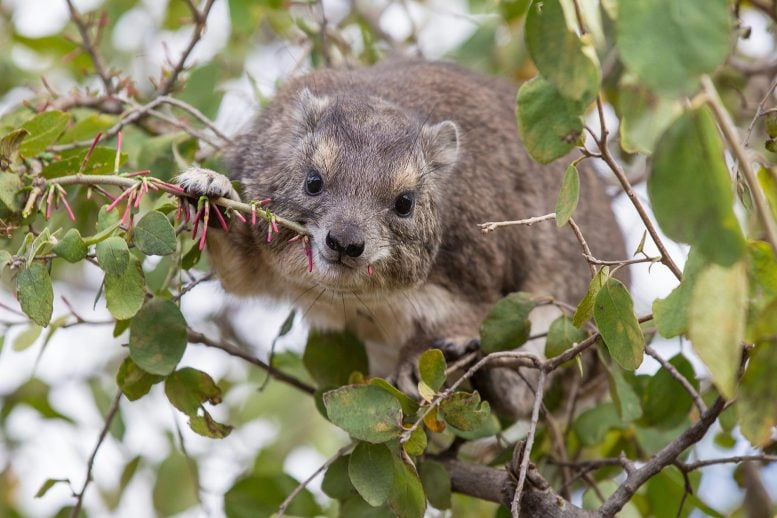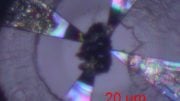
Tree Hyrax
The raucous calls of tree hyraxes — small, herbivorous mammals — reverberate through the night in the forests of West and Central Africa, but their sound differs depending on the location.
Tree hyraxes living between the Volta and Niger rivers make a barking call that is distinct from the shrieking vocalizations of hyraxes inhabiting other regions of the African forest zone.
A new study in the Zoological Journal of the Linnean Society co-authored by Yale anthropologist Eric Sargis finds that the barking hyraxes are a separate species from their shrieking neighbors. The newly described species, Dendrohyrax interfluvialis, populates the wet and dry forests that lie between the two rivers in coastal regions of southeastern Ghana, southern Togo and Benin, and southwestern Nigeria.
The researchers based their conclusion on the distinctive calls combined with anatomical and genetic differences they identified among tree hyrax populations.
“Sometimes a keen ear is as important as a sharp eye,” said Sargis, curator of mammalogy and vertebrate paleontology at the Yale Peabody Museum of Natural History. “My co-authors John Oates and Simon Bearder were in Nigeria in 2009 researching galagos, a group of primates, when they noticed that the hyrax calls were different on one side of the Niger from the other. All the evidence we subsequently studied, including the distinctive vocalizations, points to a unique species in the forests between the Niger and the Volta.”
Adult tree hyraxes typically weigh between 5 and 7 pounds (2.3 to 3.2 kilograms) — about the size of a groundhog — but they are closely related to elephants and manatees. They are usually regarded as nocturnal and tree-dwelling, but their behavior has proved difficult to study, in part because, unlike most nocturnal mammals in Africa, their eyes don’t shine at night, making them more difficult to spot, the researchers explained.
The researchers studied 418 recordings of tree hyrax calls made between 1968 and 2020 at 42 sites in 12 countries. Bearder, emeritus professor at Oxford Brookes University, produced sonograms from a sample of the 96 clearest and most complete recordings, including 34 from the population between the Niger and Volta and 62 from tree hyrax populations across West, Central, and East Africa, measuring their duration, frequency range, and repetition rates, among other characteristics. This analysis revealed that nearly all the calls recorded between the rivers were “rattle-barks” that differed from the shrieking calls recorded on the western side of the Volta and the eastern side of the Niger.
Sargis and co-author Neal Woodman of the U.S. Geological Survey and the Smithsonian National Museum of Natural History also studied the skulls of 69 adult tree hyrax specimens from six museum collections in Europe and North America. They found subtle but clear differences in the shape and size of skulls from specimens collected between the rivers and those gathered elsewhere. The skulls of D. interfluvialis were shorter and broader than those of their counterparts from outside the interfluvial zone, the study found.
An examination of museum skins, carcasses of hyraxes killed by hunters, and camera-trap imagery obtained in Ghana by co-author Edward Wiafe of the University of Environment and Sustainable Development revealed differences in fur color between D. interfluvialis and other populations, with the flanks and limbs of the former being brindled dark brown and lighter yellow-brown while the latter are dark brown to nearly black. Finally, genetic analyses of 21 samples of hyrax tissue from across the African rainforest found that the interfluvial populations were genetically distinct from other hyrax lineages, according to the study.
Oates, emeritus professor of anthropology at Hunter College in New York City, coordinated the study’s various analyses. He has been studying the biogeography of the region inhabited by the newly described species since 1964, when he first heard the nocturnal calls of tree hyraxes on Bioko Island.
“There is increasing evidence that the Niger and Volta Rivers are significant biogeographic barriers to a range of mammals,” Oates said. “Hyraxes, for instance, don’t cross water easily, so it makes sense that, through millions of years of changing climate, as African forests have expanded and contracted, new species would have differentiated in isolated forest fragments known as refugia, and then have been limited in their subsequent dispersal by large rivers.”
As a result, the region between the Volta and Niger now contains many unique animal species, the authors explain. The researchers warn, however, that the wildlife of the region between the Volta and Niger is under severe threat due to large and still growing human populations. Its forests have been reduced to fragments through a combination of commercial logging, tree cutting for firewood and charcoal production, plantation agriculture, and subsistence farming, they note, while most of the larger mammals are hunted for their meat. They call for increased efforts to create effective new nature reserves.
Reference: “A new species of tree hyrax (Procaviidae: Dendrohyrax) from West Africa and the significance of the Niger–Volta interfluvium in mammalian biogeography” by John F Oates, Neal Woodman, Philippe Gaubert, Eric J Sargis, Edward D Wiafe, Emilie Lecompte, Françoise Dowsett-Lemaire, Robert J Dowsett, Sery Gonedelé Bi, Rachel A Ikemeh, Chabi A M S Djagoun, Louise Tomsett and Simon K Bearder, 15 June 2021, Zoological Journal of the Linnean Society.
DOI: 10.1093/zoolinnean/zlab029









Be the first to comment on "Raucous Barks Reverberating in the Night Lead to the Discovery of New Species"